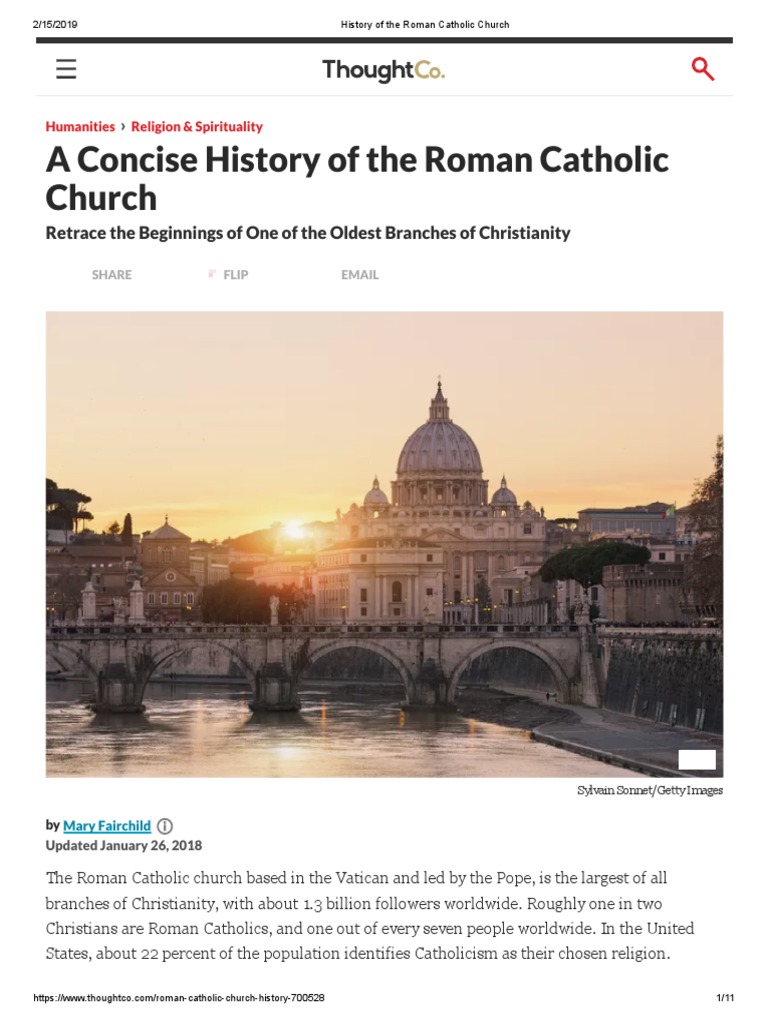The origins of the Catholic Church are etched into the annals of history, tracing a lineage back to the life and ministry of Jesus Christ in the first century. While the term “Catholic” means “universal,” symbolizing a collective of believers across diverse cultures and backgrounds, the foundations of this religion emerged in a specific milieu shaped by various political, social, and theological factors. To understand when the Catholic Church truly started, it is imperative to unravel these roots and examine the significant developments that contributed to its evolution over the centuries.
The nascent stages of what would become the Catholic Church began with the ministry of Jesus, whose teachings galvanized a group of followers in Judea and Galilee. After his crucifixion, resurrection, and subsequent ascension, these followers—primarily the apostles—continued to propagate his message. Around the year 30 AD, the early Christian community, characterized by fervent prayer, communal living, and the sharing of resources, began to solidify its beliefs and practices.
Central to this period was the Day of Pentecost, roughly ten days after Jesus’ ascension. On this occasion, the Holy Spirit descended upon the apostles, empowering them to preach boldly about Christ’s resurrection. This event is often considered the “birthday” of the Church, marking the commencement of widespread evangelization. The apostle Peter emerged as a pivotal figure during this time, regarded by many as the first leader of the Christian movement.
As the early believers faced persecution from both Jewish authorities and the Roman Empire, they began to establish communities throughout the Mediterranean. The epistles written by apostles—most notably Paul—were instrumental in shaping early Christian theology. These letters addressed pressing issues, provided guidance, and articulated beliefs, serving as a binding force for believers scattered across various regions.
In the first few centuries, the Christian faith was not yet a monolithic entity. Various doctrines and interpretations coexisted, as evidenced by numerous theological debates. The early Church grappled with questions about the nature of Christ, the Trinity, and the authority of scripture. Significant councils, such as the Council of Nicaea in 325 AD, were convened to address these theological disputes and to forge a unified doctrine. The Nicene Creed emerged from this council, a declaration of faith that encapsulated core Christian beliefs.
The eventual conversion of Emperor Constantine in the early fourth century marked a watershed moment for Christianity. In 313 AD, the Edict of Milan legalized Christianity, leading to its emergence from the shadows of persecution. This newfound legitimacy fostered remarkable growth. Consequently, the Church began to enjoy imperial favor, which would shape its organizational structure and expand its influence.
As Christianity became intertwined with the political fabric of the Roman Empire, the Bishop of Rome—known as the Pope—emerged as a central figure in ecclesiastical governance. This papal authority can be traced to the belief that Peter, whom Christ designated as the “rock” of the Church, established a line of succession within the Roman community. By the fifth century, the Pope was increasingly viewed as the spiritual leader of the broader Christian world, marking the evolution of the bishopric into a focal point of ecclesial authority.
The fall of the Western Roman Empire in 476 AD precipitated further changes in the Church’s role. As political structures collapsed, the Catholic Church increasingly assumed a stabilizing influence in Europe. Monasteries flourished during this time, serving as centers of learning, literacy, and agricultural development. Notably, figures like Saint Benedict became pivotal in establishing monastic communities that contributed to the preservation of Christian teaching and classical texts during the so-called Dark Ages.
The Middle Ages witnessed the consolidation of papal authority and the establishment of a distinct Catholic identity. The Church played an instrumental role in shaping cultural and intellectual life, guiding moral and ethical standards within society. The doctrines of the Church became standardized, and liturgical practices were codified, resulting in a rich tapestry of rituals that encompassed the liturgical year.
As the Church solidified its power, it also faced challenges. The East-West Schism in 1054 divided Christianity into the Western Roman Catholic Church and the Eastern Orthodox Church, a significant theological and political split that remains influential to this day. This division was exacerbated by differences in beliefs, language, and governance, yet it underscored the diverse expressions of faith within Christianity.
The subsequent period of the Reformation in the 16th century brought about seismic shifts within the Catholic Church itself. Reformers like Martin Luther and John Calvin challenged established practices and raised fundamental questions about salvation, grace, and the authority of the Church. The Catholic response included the Counter-Reformation, marked by the Council of Trent, which sought to address the concerns raised by reformers, reaffirming key doctrines and reorganizing ecclesial practices.
In contemporary times, the Catholic Church remains a dynamic and evolving institution. It continues to navigate an ever-changing global landscape while being characterized by its commitment to the sacraments, the veneration of saints, and a rich tradition that spans millennia. Today, the Catholic Church boasts a diverse global community, reflecting the universality that is inherent in its name.
In conclusion, the Catholic Church originated in the first century AD and has undergone immense transformation through various historical milestones. From the early community of believers to its establishment as a powerful institution, the Church’s evolution is a testament to both its resilience and its adaptability. The Catholic Church stands as a profound legacy of faith that continues to influence millions of adherents worldwide, shaping both individual lives and collective cultural identities.



